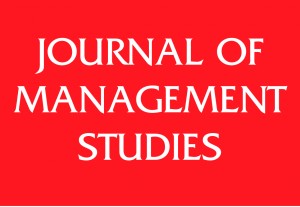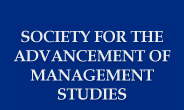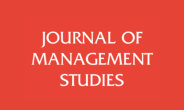
Special Issue Call for Papers:
Strategy, Innovation, and New Ventures
in the New Normal Global Business Landscape
Submission Deadline: 31st January 2018
Guest Editors:
David Ahlstrom, The Chinese University of Hong Kong, Dept. of Management (ahlstrom@baf.cuhk.edu.hk)
Jean-Luc Arregle, EM Lyon Business School (arregle@em-lyon.com)
Michael A. Hitt, Texas Christian University, Neeley School of Business and Texas A&M University, Mays School of Business (m.a.hitt@tcu.edu)
Xufei Ma, The Chinese University of Hong Kong, Dept. of Management (xufei@baf.cuhk.edu.hk)
Gongming Qian, The Chinese University of Hong Kong, Dept. of Management (qian@baf.cuhk.edu.hk)
JMS Editor:
Dries Faems, University of Groningen, Dept. of Innovation Management & Strategy (d.l.m.faems@rug.nl)
Overview
At the end of the 1990s, Hitt and colleagues (Hitt, Keats & DeMarie, 1998) introduced the notion of the new competitive landscape to describe the emergence of a changing business environment. That newer environment was characterized by more turbulent and technology-intensive conditions where some firms (and countries) grew at almost unheard of rates and new competitors could appear unexpectedly, assisted by new technologies as well as the increased globalization that facilitated market entry, cost arbitrage, and scale. However, the current competitive landscape is shifting once again. Since the worldwide financial crisis of 2008 and its aftermath, coupled with simmering populist concerns, we are seeing emergence of a new business landscape changing the environment for firms once again – i.e. a New Normal whereby something that was previously unusual has started to become more commonplace (El-Erian, 2010; Hitt, Li, & Xu, 2016). In a 2010 talk titled Navigating the New Normal in Industrial Countries, the head of PIMCO, Mohamed A. El-Erian stated: “Our use of the term was an attempt to move the discussion beyond the notion that the [financial] crisis was a mere flesh wound…instead the crisis cut to the bone. It was the inevitable result of an extraordinary, multiyear period which was anything but normal.” International Monetary Fund Director, Christine Lagarde, added in October 2014 that the advanced economies may be facing a “new mediocre,” while former U.S. Secretary of the Treasury, Lawrence Summers, foresaw an era of “secular stagnation.”
The New Normal
It has become increasingly clear that a restructuring of the economic order has been taking place, and has particularly affected multinational enterprises (MNEs), and others doing business across borders. After the 2008 crisis for example, capital flows between countries and trade in goods and services have retreated significantly to levels not seen in a quarter century (Sharma, 2016: 2). Foreign direct investment has fallen from its pre-crisis high of over $3 trillion to around $2 trillion in 2015 (The World Bank, 2017). The more developed economies could linger in a low-level growth equilibrium for an unusually prolonged period (El-Erian, 2016). High debts caused in part by heavy reliance on accommodating monetary policy, may be prolonging that equilibrium. This may also mean costlier capital, an expanded role for governments, and a much larger burden of regulation and taxation for all, as firms find it more difficult to shift activities and park funds in the most favorable locations.
Before the financial crash, many companies had moved or were moving toward globally integrated structures, many encompassing hundreds of locations for various corporate activities. But the notion that we live in a world where the constituent parts of enterprises can be unbundled and distributed almost anywhere at will has been challenged by economic volatility, and changing political sentiments regarding borders, trade, and disruptive new (often local) competitors. The related inattention to the negative labor market and legitimacy consequences of trade and globalization may have further helped to energize populists opposition and the issues for multinational enterprises. At the same time, labor markets have become less dynamic and flexible, contributing to increasing inequality, which itself is hurting economic growth and increasing resentment toward wealthier individuals and firms, and the free trade they encourage (Autor, Dorn, and Hanson, 2016). This labor inflexibility is also seen in projections forecasting shortfalls in the global supply of many categories of engineers and other technical personnel.
The New Normal economy thus challenges how businesses are organized and governed, and even raises concerns with respect to their position in previously difficult-to-contest markets based on scale and scope economies and other thought-to-be strong barriers to competition (Davis, 2016). Global firms and entrepreneurs alike must account for these developments in terms of their plans and strategies in the coming years. Thus, the purpose of this Special Issue (SI) is to explore and explain the ways in which the New Normal affects strategies, innovation, and new venture activity.
Core Goals of the Special Issue
First, this SI seeks a clearer conceptualization of the New Normal. Which major economic and commercial changes have occurred and are occurring during this time? How do these changes influence different environmental conditions related to economic growth, industrial environments, commercial practices, and important formal and informal institutions?
Second, this SI also seeks to increase our understanding of how the New Normal conditions impact key actors at various levels such as MNEs, suppliers, entrepreneurs, investors, and customers. We hope to refine our understanding of the contexts wherein the New Normal is most likely to have its greatest impact.
Third, this SI hopes to provide a better understanding of how the New Normal conditions unfolding in different domains and different locations may have impact across different actors and ecosystems. Our SI will also seek manuscripts that address big research questions across levels of analysis and create foundational knowledge on a range of topics that addresses the strategic, operational, governance, institutional and performance consequences of the New Normal environment. Contributors are encouraged to provide not only quantitative or qualitative empirical evidence, but also new theory and concepts that can help to explain how some firms are able to adapt to and profit from the New Normal environment.
Possible topics
There are a number of topics/issues that can be addressed in the SI. In particular, it seeks to examine firm strategies, innovation, cooperation, and new venture creation in this New Normal environment. Several possible topics for the SI are provided below, though they need not be limited to these.
- Strategies
- Global and Business Level
Globalization in the New Normal: A positive or malevolent force? In many developed countries, optimistic and positive feelings about a “Global World” have been replaced by negative ones, blaming globalization and unrooted, widely distributed corporate structures for existing economic or societal problems. How have MNEs been dealing with these legitimacy concerns? Are they purely problems of perception and reputation, or can something else be done?
- Entry-related issues in the New Normal: In recent years, lower-tech, less environmentally-friendly industries have been less desired by many host countries, while industries using high-tech and clean-energy are preferred. How have potential multinational entrants responded to these and other changes in industrial policies and how they should respond?
- Exit-related issues in the New Normal: Given the increase in the cost of doing business in some formerly “hot” host countries such as China in which costs are rising, how will multinational firms design and implement retrenchment or exit strategies if it becomes necessary to back out of foreign investments? Will they return to their home countries?
- Regional strategies in the New Normal: Companies whose strategies currently emphasize flexible supply chains, arbitraging costs, and achieving economies of scale across national boundaries may need to shift toward embeddedness, adapting to local conditions. Companies whose strategies emphasize arbitrage—taking advantage of differences—may need to make the same shift.
- Strategies – Corporate (Mergers & Acquisitions, Strategic Alliances)
In the face of economic slowdown, overcapacity and low interest rates, there are numerous questions and issues related to use of corporate strategies in the new environment:
- What types of M&A or alliances are most effective for a firm to deal with environmental challenges of the New Normal?
- What potential difficulties/problems with the corporate strategies exist under the New Normal that may not have been problems before the changes of the past decade?
- Will M&As enable firms to take advantage of environmental changes in the New Normal?
- Will M&As prompt domestic firms to increase the pace of international market expansion under the New Normal?
- What attitudes of governments towards M&As and particularly towards international M&As are likely to exist? Are they preventing or encouraging M&As under the New Normal?
- What strategies can firms best use to achieve their desired growth?
- Innovation
- In the New Normal, economic weakness, extra capacity, and possibly a shift in the zeitgeist toward more frugality, may put downward pressure on prices. Expansion into poorer markets at home and abroad will intensify this trend. How should firms respond to this pressure (and opportunities)?
- Are more entrepreneurs and firms pursuing disruptive innovation in the New Normal and what are the outcomes of this innovation strategy?
- A sustainable competitive position is more difficult if a company is unable to innovate its business model. How do firms develop business model innovations in the New Normal?
- How does management innovation help firms design and implement organizational transformation in the New Normal?
- Why and how do firms conduct social innovations for a sustainable development in the New Normal?
- Market-creating innovations use capital to scale up to a greater extent than more common incremental innovations to enhance efficiency. How can these crucial market-creating innovations be encouraged in the New Normal?
- New ventures
- Does the New Normal enhance or hinder entrepreneurial activity?
- What forms of new ventures may be required for the New Normal?
- What are the mechanisms for firms to conduct new opportunity discovery, evaluation, and exploitation in the New Normal?
- How do new entrepreneurial firms adapt to changes such as low interest rates and trade barriers in the New Normal?
- In the New Normal, what strategies help new entrepreneurial firms to strengthen their competitiveness domestically and internationally?
- The New Normal conditions also suggest that efficiency ratios such as ROI may not be as helpful for resource allocation decisions. What other measures are appropriate for managers and venture capitalists to use in making investment decisions?
- How is economic growth proceeding in the New Normal compared to the past two decades? Are the most commonly publicized figures masking things of which management and IB researchers should be aware?
Submission Process and Deadlines
- Submissions should be prepared using the JMS Manuscript Preparation Guidelines.
- Manuscripts should be submitted by 31st January 2018 to Margaret Turner (jms@durham.ac.uk).
- Manuscripts will be reviewed according to the JMS double-blind review process.
- For informal inquires related to the Special Issue, proposed topics and potential fit with the Special Issue objectives, please contact the guest editors.
Special Issue Workshop: To help authors advance their manuscripts, a Special Issue Workshop may be held on or around 9 August 2018 (possibly immediately before the Academy of Management Annual Meeting in Chicago, USA). If there is a workshop, authors of R&R manuscripts will be invited to present and discuss their papers during the workshop. However, presentation at the workshop will not guarantee acceptance of a paper for publication in JMS. Also, attending the workshop will not be a precondition for acceptance of a paper for the Special Issue.
Articles Cited
Autor, D. H., Dorn, D. and Hanson, G. H. (2016). The China shock: Learning from labor market adjustment to large changes in trade. Working Paper 21906. Cambridge, MA: National Bureau of Economic Research (http://www.nber.org/papers/w21906).
Belk, R. (2014). ‘You are what you can access: Sharing and collaborative consumption online’. Journal of Business Research, 67, 1595-600.
Christensen, C. M. and Raynor, M. E. (2013). The innovators solution: Creating and sustaining successful growth. Boston, MA: Harvard Business School Press.
Davis, G. F. (2016). The vanishing American corporation: Navigating the hazards of a new economy. Ann Arbor, MI: Berrett-Koehler Publishers.
El-Erian, M. A. (2010). ‘Navigating the New Normal in industrial countries’. International Monetary Fund, 15 December, p.12 (Retrieved 18 October 2015).
El-Erian, M. A. (2016). The only game in town: Central banks, instability, and avoiding the next collapse. New York: Random House.
Hitt, M. A., Keats, B. W. and DeMarie, S. M. (1998). ‘Navigating in the new competitive landscape: Building strategic flexibility and competitive advantage in the 21st century’. Academy of Management Executive, 12, 22-42.
Hitt, M. A., Li, D. and Xu, K. (2016). ‘International strategy: From local to global and beyond’. Journal of World Business, 51, 58-73.
Matzler, K., Veider, V. and Kathan, W. (2015). ‘Adapting to the sharing economy’. MIT Sloan Management Review, 56, 71-77.
McCloskey, D. N. (2016). Bourgeois equality: How ideas, not capital or institutions, enriched the world. Chicago, IL: University of Chicago Press.
Peng, M. W. (2004). ‘Identifying the big question in international business research’. Journal of International Business Studies, 35, 99-108.
Rumelt, R., Schendel, D. and Teece, D. (eds.) (1994) Fundamental Issues in Strategy: A Research Agenda. Boston, MA: Harvard Business School Press.
Sinfield, J. and Solis, F. (2016). ‘Finding a lower-risk path to high-impact innovations’. MIT Sloan Management Review, 57, 79-89.
Sharma, R. (2016). The rise and fall of nations: Forces of change in the post-crisis world. New York: WW Norton.
Sundararajan, A. (2016). The sharing economy: The end of employment and the rise of crowd-based capitalism. Cambridge, MA: MIT Press.
The World Bank (2017). Foreign direct investment, net inflows (BoP, current US$). http://data.worldbank.org/indicator/BX.KLT.DINV.CD.WD (Accessed 9 January 2017).
Zhang, X., Yang, J. and Wang, S. (2011). ‘China has reached the Lewis Turning Point’. China Economic Review, 22, 542-54.

